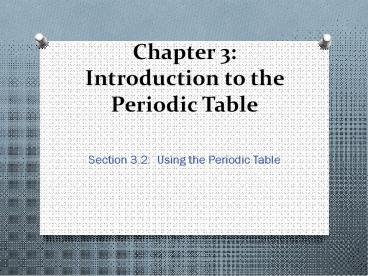Chapter 3: Introduction to the Periodic Table - PowerPoint PPT Presentation
1 / 16
Title:
Chapter 3: Introduction to the Periodic Table
Description:
Chapter 3: Introduction to the Periodic Table Section 3.2: Using the Periodic Table Objectives: Relate an element s valence electron structure to its position in ... – PowerPoint PPT presentation
Number of Views:119
Avg rating:3.0/5.0
Title: Chapter 3: Introduction to the Periodic Table
1
Chapter 3 Introduction to the Periodic Table
- Section 3.2 Using the Periodic Table
2
- Objectives Relate an elements valence electron
structure to its position in the periodic table,
Use the periodic table to classify an element as
a metal, nonmetal or metalloid, Compare the
properties of metals, nonmetals or metalloids
3
Arrangement
- Elements are arranged according to atomic number
- Atomic number electrons/ protons
- PERIOD- horizontal row in the table
- GROUP (family)- vertical column in the table
- For elements in group 1 and 2
- The group number equals the number of valence
electrons - For elements in groups 13, 14, 15, 16, 17, 18
- The second digit in the group number is equal to
the number of valence electrons
4
Arrangement
- Elements in the same group have the same number
of valence electrons, similar properties - http//www.ptable.com/
- Alkali metals are elements in Group 1 (most
reactive metals) - Alkaline earth metals are elements in Group 2
- Halogens are elements in Group 17 (most
reactive nonmetals) - NOBLE GASES Elements in Group 18
- Maximum 8 valence electron- unreactive octet
rule
5
Physical states of elements
- Most elements are solid, only 2 elements are
liquid (Br, Hg) - Gaseous elements are in the upper-right corner of
the table, except hydrogen - Some elements are not found in nature- synthetic
elements are produced artificially - Include Element 43, Technetium
- All elements after element 92, Uranium
6
Classifying Elements
- Majority of elements are metals- left side and
center - Nonmetals- upper-right-hand corner
- Metalloids- along the boundary between metals and
nonmetals - http//www.ptable.com/
7
METALS
- Metals have 1, 2, or 3 valence electrons - except
Lead, Bismuth, and Tin - Strong and durable
- Have luster, conduct heat and electricity
- Usually bend without breaking
- All metals are solid at room temp, except Hg
- Good conductors
8
METALS
- TRANSITION ELEMENTS Elements in groups 3
through 12 of the periodic table - Predicting behavior and properties of transition
metals is complicated due to the atomic structure
of these elements - Inner Transition Elements
- Placed below the periodic table- proper position
would make table too wide
9
METALS
- LANTHANIDES- first series of inner transition
elements - Elements 58-71, also called rare earth elements
- ACTINIDES- second series of inner transition
elements - Elements 90-103, all are radioactive
10
NONMETALS
- Poor conductors of electricity and heat, and are
brittle as solids - Many are gases at room temperature, lower melting
points than metals - Nonmetals have 5, 6, 7, 8 valence electrons,
except Carbon
11
Metals and Nonmetals
- Atomic Structure
- Metals
- Valence electrons are loosely bound to the
positive nucleus - Electrons are free to move in the solid metal and
are easily lost - This motion allows for their good conductivity
12
METALLOIDS
- Elements that have chemical and physical
properties of metals and nonmetals - Ex Silicon, Germanium, Arsenic
- Form border between metals and nonmetals
- Some metalloids are semiconductors.
13
METALLOIDS
- SEMICONDUCTOR Element that does not conduct
electricity as well as metal, but does conduct
slightly better than a nonmetal - Valence electrons in nonmetals and metalloids are
tightly held to the nucleus - In reactions, nonmetals tend to share or gain
electrons - http//www.youtube.com/watch?vu3GdpbKTPQQsafety_
modetruepersist_safety_mode1safeactive
14
METALLOIDS
- Semiconductor uses
- Used in electronic devices (circuits) TV,
computers, calculators - Semiconductors are doped with a small amount of
another element ? allows the movement of
electrons ? produces electricity - p-type semiconductor- creates holes that allows
electrons to move in and out - n- type semiconductor- extra electrons present
are free to move
15
METALLOIDS
- Transistors, diodes, and other semiconductors are
incorporated onto thin slices of silicon (chip)
to form integrated circuits ? growth of computer
technology
16
- MATCHING CONCEPTS
- Match words or phrases in column 1 with words or
phrases in column 2. It is possible to have
multiple connectionsfind as many as you can!
BUT, be able to justify the connection! - COLUMN 1 COLUMN 2
- Conductivity Inner Transition Element
- Group Family
- Nonmetal State of Matter
- Mendeleev Semiconductor
- Energy Level Metal
- Silver Alkali Metal
- Liquid Mercury
- Lanthanides Bromine
- Sodium Noble Gas
- Alkaline Earth Metal Group 2
- Group 18 Periodicity
- Halleys Comet Group 1
- Solid Magnesium
- Metalloid Actinide
- 7 Energy Levels Gas































